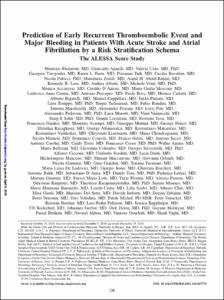Prediction of Early Recurrent Thromboembolic Event and Major Bleeding in Patients With Acute Stroke and Atrial Fibrillation by a Risk Stratification Schema The ALESSA Score Study
- Affiliated Author(s)
- 손성일
- Alternative Author(s)
- Sohn, Sung Il
- Journal Title
- Stroke
- ISSN
- 0039-2499
- Issued Date
- 2017
- Abstract
- Background and Purposes—This study was designed to derive and validate a score to predict early ischemic events and major bleedings after an acute ischemic stroke in patients with atrial fibrillation.
Methods—The derivation cohort consisted of 854 patients with acute ischemic stroke and atrial fibrillation included in prospective series between January 2012 and March 2014. Older age (hazard ratio 1.06 for each additional year; 95% confidence interval, 1.00–1.11) and severe atrial enlargement (hazard ratio, 2.05; 95% confidence interval, 1.08–2.87) were predictors for ischemic outcome events (stroke, transient ischemic attack, and systemic embolism) at 90 days from acute stroke. Small lesions (≤1.5 cm) were inversely correlated with both major bleeding (hazard ratio, 0.39; P=0.03) and ischemic outcome events (hazard ratio, 0.55; 95% confidence interval, 0.30–1.00). We assigned to age ≥80 years 2 points and between 70 and 79 years 1 point; ischemic index lesion >1.5 cm, 1 point; severe atrial enlargement, 1 point (ALESSA score). A logistic regression with the receiver-operating characteristic graph procedure (C statistic) showed an area under the curve of 0.697 (0.632–0.763; P=0.0001) for ischemic outcome events and 0.585 (0.493–0.678; P=0.10) for major bleedings.
Results—The validation cohort consisted of 994 patients included in prospective series between April 2014 and June 2016. Logistic regression with the receiver-operating characteristic graph procedure showed an area under the curve of 0.646 (0.529–0.763; P=0.009) for ischemic outcome events and 0.407 (0.275–0.540; P=0.14) for hemorrhagic outcome events.
Conclusions—In acute stroke patients with atrial fibrillation, high ALESSA scores were associated with a high risk of ischemic events but not of major bleedings.
- Department
- Dept. of Neurology (신경과학)
- Publisher
- School of Medicine
- Citation
- Maurizio Paciaroni et al. (2017). Prediction of Early Recurrent Thromboembolic Event and Major Bleeding in Patients With Acute Stroke and Atrial Fibrillation by a Risk Stratification Schema The ALESSA Score Study. Stroke, 48(3), 726–732. doi: 10.1161/STROKEAHA.116.015770
- Type
- Article
- ISSN
- 0039-2499
- Appears in Collections:
- 1. School of Medicine (의과대학) > Dept. of Neurology (신경과학)
- 파일 목록
-
-
Download
 oak-2017-0396.pdf
기타 데이터 / 601.67 kB / Adobe PDF
oak-2017-0396.pdf
기타 데이터 / 601.67 kB / Adobe PDF
-
Items in Repository are protected by copyright, with all rights reserved, unless otherwise indicated.